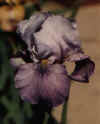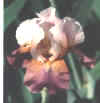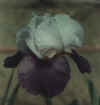|
The first section dates to the period in which I numbered crosses when I
lined out the seedlings and then numbered the individual seedlings when they were selected
for
further evaluation and consideration for introduction. The numbers are therefore no
indication of the number of crosses actually made or the number of seedlings produced by
each cross. |
|
|
|
88-8: Brandy Sipper X Tribe of Judah. |
|

|
88-8-3
Its rounded, onco-like form and distinct signal suggest that it is a
triploid -- in which case it should certainly offer some breeding potential even
though it must be classified as a quarterbred.
|
|
|
|
|
|
89-1: Sostenique X Tribe of Judah. Go to Sibling Sheet
for more details.
|
|

|
89-1-2 Quite nice, and a good performer, but not as striking as the sib
introduced as COPE GOODWIN. In retrospect, it was worthy of introduction
but at the time I thought it was too much like COPE GOODWIN.
|
 |
89-1-4 More photogenic than MAGNIFICENT OBSESSION, with better form, but without
the striking signal and not as strong-growing. |
 |
89-1-6 A striking example of the veined, blended pattern with buff
ground. Introduced as PALIMPSEST. |

|
89-1-8 A striking example of the veined, blended pattern with pinkish
ivory ground. Introduced as VIVACIOUS VI.
|

|
89-1-10 My personal favorite, introduced as COPE GOODWIN.
|

|
89-1-30 The most popular sib, the strongest performer and one of the
best signals -- but camera-shy. Introduced as MAGNIFICENT OBSESSION.
|
|
|
|
|
The following section dates to the period in which I numbered both crosses
and seedlings when I
lined out the seedlings. The numbers are still no
indication of the number of crosses actually made, but they hold a few clues as
to the number of seedlings produced by
each cross.
|
|
91-27: Goddess X Tribe of Judah Testing glaciatas with my best signal-transmitter, I got an array of complex patterns.
|

|
91-27-2 Introduced as FLAUNT IT
|
Hybridizing
Terminology. You won't find these terms in official classification
systems, but will see them in articles written by such well-known
hybridizers as Tom Wilkes and John Holden. "A" simply stands
for a set of aril chromosomes and "B" for a set of non-aril chromosomes. Fractions
were sometimes used to depict the number of sets of
aril chromosomes and the total number of sets. An AAB-type triploid
might thus be called a "2/3-bred", while "2/4" would
indicate a halfbred with two sets of aril chromosomes and two sets
of non-aril chromosomes, and "1/2" would stand for a diploid with one set of
aril chromosomes and one set of non-aril chromosomes. These
terms were once widely used by hybridizers, but fell out of favor after the
Aril Society adopted the Modified Chromosome-set Classification System but retained
the nomenclature from the older Quantum System. Today, "1/2"
usually means a fully fertile halfbred with two sets of aril and two sets of
non-aril chromosomes. I have used the old-style
hybridizers' terminology here, because it is not possible to accurately
determine the correct classification code for seedlings of this type without
extensive test crosses. |








